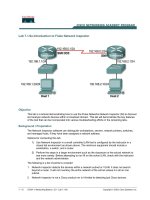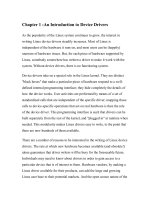Volume 1 photovoltaic solar energy 1 02 – introduction to photovoltaic technology
Bạn đang xem bản rút gọn của tài liệu. Xem và tải ngay bản đầy đủ của tài liệu tại đây (149.44 KB, 7 trang )
1.02
Introduction to Photovoltaic Technology
WGJHM van Sark, Utrecht University, Utrecht, The Netherlands
© 2012 Elsevier Ltd.
1.02.1
1.02.2
1.02.2.1
1.02.2.2
1.02.2.2.1
1.02.2.2.2
1.02.2.2.3
1.02.2.2.4
1.02.2.2.5
1.02.2.2.6
1.02.3
References
Introduction
Guide to the Reader
Quick Guide
Detailed Guide
Part 1: Introduction
Part 2: Economics and environment
Part 3: Resource and potential
Part 4: Basics of PV
Part 5: Technology
Part 6: Applications
Conclusion
Glossary
Balance of system All components of a PV energy system
except the photovoltaics (PV) modules.
Grid parity The situation when the electricity generation
cost of solar PV in dollar or Euro per kilowatt-hour equals
the price a consumer is charged by the utility for power
from the grid. Note, grid parity for retail markets is
different from wholesale electricity markets.
Inverter Electronic device that converts direct electricity to
alternating current electricity.
Photovoltaic energy system A combination of a PV
system to generate direct current electricity, the necessary
support and cabling structure, and an inverter system
to convert direct electricity to alternating current
electricity.
Photovoltaic module A number of solar cells together
form a solar ‘module’ or ‘panel’.
5
6
6
7
7
7
8
8
8
10
11
11
Photovoltaic system A number of PV modules combined
in a system in arrays, ranging from a few watts capacity to
multimegawatts capacity.
Photovoltaic technology generations PV technologies
can be classified as first-, second-, and third-generation
technologies. First-generation technologies are
commercially available silicon wafer-based technologies,
second-generation technologies are commercially
available thin-film technologies, and third-generation
technologies are those based on new concepts and
materials that are not (yet) commercialized.
Photovoltaics (PV) It is a method of generating electrical
power by converting solar radiation into direct current
electricity using predominantly semiconductors or other
materials that exhibit the PV effect.
Solar cell The device in which solar irradiation is
converted into direct current electricity.
1.02.1 Introduction
The discovery of the photoelectric effect by Edmund Becquerel as reported in 1839 [1] has led to a multibillion solar photovoltaics
(PVs) business today. The scientific discoveries by Max Planck [2] and Albert Einstein [3] in the early 1900s led to the first silicon
solar cell made by Daryl Chapin, Calvin Fuller, and Gerald Pearson in 1954 [4]. Now, nearly 60 years later, this same solar cell
design, in essence, is responsible for over 40 GW of installed solar power systems worldwide.
Figure 1 shows the development of annual PV production for the past 20 years [5]. Clearly, a nearly 1000-fold increase has
occurred in these two decades, while the relative annual growth has also increased steadily, averaging over 50% over the past
10 years. Popular policy measures, such as the feed-in-tariff scheme pioneered in Germany, have pushed these developments
forward [6]. The growth figures have to be sustained for the coming decades to reach global installed capacity, such that PV
technology will be one of the major renewable electricity suppliers in a future sustainable society [7].
PV has become better and cheaper over the past decades. Starting with an efficiency of 7% in 1954, due to considerable amounts
of public and private R&D funding, crystalline silicon wafer-based solar cells now have reached an efficiency of 25%, while cells that
use other materials have reached an absolute record efficiency of 43.5% (two-terminal triple-junction GaInP/GaAs/GaInNAs, at an
intensity of 418 suns) [8]. The magic 50% limit now becomes within reach, as recently reviewed by Antonio Luque [9]: intermediate
band cell is considered to be as one of the best candidates.
From some $100 Wp−1 in the mid-1970s, present-day PV module prices have decreased to between $1 and $2 Wp−1 today. Price
development seems to follow a so-called experience curve, meaning that for every doubling of the produced amount of PV modules,
����������������������������������������������������������������������������������������������������������������������������������������������������������������������������������������������������������������������������������������������������������������������������������������������������������������������������������������������������������������������������������������������������������������������������������������������������������������������������������������������������������������������������������������������������������������������������������������������������������������������������������������������������������������������������������������������������������������������������������������������������������������������������������������������������������������������������������������������������������������������������������������������������������������������������������������������������������������������������������������������������������������������������������������������������������������������������������������������������������������������������������������������������������������������������������������������������������������������������������������������������������������������������������������������������������������������������������������������������������������������������������������������������������������������������������������������������������������������������������������������������������������������������������������������������������������������������������������������������������������������������������������������������������������������������������������������������������������������������������������������������������������������������������������������������������������������������������������������������������������������������������������������������������������������������������������������������������������������������������������������������������������������������������������������������������������������������������������������������������������������������������������������������������������������������������������������������������������������������������������������������������������������������������������������������������������������������������������������������������������������������������������������������������������������������������������������������������������������������������������������������������������������������������������������������������������������������������������������������������������������������������������������������������������������������������������������������������������������������������������������������������������������������������������������������������������������������������������������������������������������������������������������������������������������������������������������������������������������������������������������������������������������������������������������������������������������������������������������������������������������������������������������������������������������������������������������������������������������������������������������������������������������������������������������������������������������������������������������������������������������������������������������������������������������������������������������������������������������������������������������������������������������������������������������������������������������������������������������������������������������������������������������������������������������������������������������������������������������������������������������������������������������������������������������������������������������������������������������������������������������������������������������������������������������������������������������������������������������������������������������������������������������������������������������������������������������������������������������������������������������������������������������������������������������������������������������������������������������������������������������������������������������������������������������������������������������������������������������������������������������������������������������������������������������������������������������������������������������������������������������������������������������������������������������������������������������������������������������������������������������������������������������������������������������������������������������������������������������������������������������������������������������������������������������������������������������������������������������������������������������������������������������������������������������������������������������������������������������������������������������������������������������������������������������������������������������������������������������������������������������������������������������������������������������������������������������������������������������������������������������������������������������������������������������������������������������������������������������������������������������������������������������������������������������������������������������������������������������������������������������������������������������������������������������������������������������������������������������������������������������������������������������������������������������������������������������������������������������������������������������������������������������������������������������������������������������������������������������������������������������������������������������������������������������������������������������������������������������������������������������������������������������������������������������������������������������������������������������������������������������������������������������������������������������������������������������������������������������������������������������������������������������������������������������������������������������������������������������������������������������������������������������������������������������������������������������������������������������������������������������������������������������������������������������������������������������������������������������������������������������������������������������������������������������������������������������������������������������������������������������������������������������������������������������������������������������������������������������������������������������������������������������������������������������������������������������������������������������������������������������������������������������������������������������������������������������������������������������������������������������������������������������������������������������������������������������������������������������������������������������������������������������������������������������������������������������������������������������������������������������������������������������������������������������������������������������������������������������������������������������������������������������������������������������������������������������������������������������������������������������������������������������������������������������������������������������������������������������������������������������������������������������������������������������������������������������������������������������������������������������������������������������������������������������������������������������������������������������������������������������������������������������������������������������������������������������������������������������������������������������������������������������������������������������������������������������������������������������������������������������������������������������������������������������������������������������������������������������������������������������������������������������������������������������������������������������������������������������������������������������������������������������������������������������������������������������������������������������������������������������������������������������������������������������������������������������������������������������������������������������������������������������������������������������������������������������������������������������������������������������������������������������������������������������������������������������������������������������������������������������������������������������������������������������������������������������������������������������������������������������������������������������������������������������������������������������������������������������������������������������������������������������������������������������������������������������������������������������������������������������������������������������������������������������������������������������������������������������������������������������������������������������������������������������������������������������������������������������������������������������������������������������������������������������������������������������������������������������������������������������������������������������������������������������������������������������������������������������������������������������������������������������������������������������������������������������������������������������������������������������������������������������������������������������������������������������������������������������������������������������������������������������������������������������������������������������������������������������������������������������������������������������������������������������������������������������������������������������������������������������������������������������������������������������������������������������������������������������������������������������������������������������������������������������������������������������������������������������������������������������������������������������������������������������������������������������������������������������������������������������������������������������������������������������������������������������������������������������������������������������������������������������������������������������������������������������������������������������������������������������������������������������������������������������������������������������������������������������������������������������������������������������������������������������������������������������������������������������������������������������������������������������������������������������������������������������������������������������������������������������������������������������������������������������������������������������������������������������������������������������������������������������������������������������������������������������������������������������������������������������������������������������������������������������������������������������������������������������������������������������������������������������������������������������������������������������������������������������������������������������������������������������������������������������������������������������������������������������������������������������������������������������������������������������������������������������������������������������������������������������������������������������������������������������������������������������������������������������������������������������������������������������������������������������������������������������������������������������������������������������������������������������������������������������������������������������������������������������������������������������������������������������������������������������������������������������������������������������������������������������������������������������������������������������������������������������������������������������������������������������������������������������������������������������������������������������������������������������������������������������������������������������������������������������������������������������������������������������������������������������������������������������������������������������������������������������������������������������������������������������������������������������������������������������������������������������������������������������������������������������������������������������������������������������������������������������������������������������������������������������������������������������������������������������������������������������������������������������������������������������������������������������������������������������������������������������������������������������������������������������������������������������������������������������������������������������������������������������������������������������������������������������������������������������������������������������������������������������������������������������������������������������������������������������������������������������������������������������������������������������������������������������������������������������������������������������������������������������������������������������������������������������������������������������������������������������������������������������������������������������������������������������������������������������������������������������������������������������������������������������������������������������������������������������������������������������������������������������������������������������������������������������������������������������������������������������������������������������������������������������������������������������������������������������������������������������������������������������������������������������������������������������������������������������������������������������������������������������������������������������������������������������������������������������������������������������������������������������������������������������������������������������������������������������������������������������������������������������������������������������������������������������������������������������������������������������������������������������������������������������������������������������������������������������������������������������������������������������������������������������������������������������������������������������������������������������������������������������������������������������������������������������������������������������������������������������������������������������������������������������������������������������������������������������������������������������������������������������������������������������������������������������������������������������������������������������������������������������������������������������������������������������������������������������������������������������������������������������������������������������������������������������������������������������������������������������������������������������������������������������������������������������������������������������������������������������������������������������������������������������������������������������������������������������������������������������������������������������������������������������������������������������������������������������������������������������������������������������������������������������������������������������������������������������������������������������������������������������������������������������������������������������������������������������������������������������������������������������������������������������������������������������������������������������������������������������������������������������������������������������������������������������������������������������������������������������������������������������������������������������������������������������������������������������������������������position techniques are used, each having its own advantages and disadvantages regarding cost, scalability, and throughput.
Recently, commercialization of chalcopyrite thin film has been scaled up to the gigawatt range, proving the competitiveness of this
technology with regard to crystalline silicon solar technology.
Chapter 1.19 by Tim Gessert reviews the history, development, and present processes used to fabricate thin-film CdTe-based
solar cells. It shows why certain processes may have commercial production advantages, and how the various process steps can
interact with each other to affect device performance and reliability. The chapter concludes with a discussion of considerations of
large-area CdTe PV deployment including issues related to material availability and EPBT.
In Chapter 1.20, plastic or organic solar cells are described by Lothar Sims, Hans Egelhaaf, Jens Hauch, René Kogler, and Roland
Steim. Organic solar cells are also considered a great promise to reduce costs as well as energy consumption during production
compared with wafer-based silicon PV technologies. Properties such as transparency, flexibility, and various colors also make them
attractive from an aesthetic point of view. This chapter describes the working principles of these cells, important materials, such as
Introduction to Photovoltaic Technology
9
P3HT:PCBM (poly(3-hexylthiophene):phenyl-C61-butyric-acid-methyl ester), ways for improving the efficiency and stability,
production methods, and ends with a short outlook on the future development of organic solar cells.
Anders Hagfeldt, Ute Cappel, Gerrit Boschloo, Licheng Sun, Lars Kloo, Henrik Pettersson, and Elizabeth Gibson discuss the
developments in mesoporous dye-sensitized solar cells (DSCs, also called Grätzel cells) in Chapter 1.21. In these cells, a dye is
distributed over a porous material with a large surface area, and electrons which are excited upon absorption of photons are
transferred from the dye to the porous substrate and collected via external contacts. It is shown in this chapter that the chemical
complexity of DSCs has become clear, and the main challenge for future research is to understand and master this complexity, in
particular at the oxide–dye–electrolyte interface. A challenging but realistic goal for the present DSC technology is to achieve
efficiencies above 15% that are also stable. As DSCs perform relatively better compared with other solar cell technologies under
diffuse light conditions, an overall goal for future research will be to collect data and develop models to make fair judgments of the
DSC technology with regard to energy costs. Possible introduction of niche applications such as consumer electronics and successful
development of manufacturing processes are expected.
Multiple-junction solar cells based on III–V materials are described in Chapter 1.22 by Masafumi Yamaguchi. These types of solar
cells are capable of reaching efficiencies of up to 50% and are used for space and terrestrial applications, in particular in concentrator
solar cell modules, as the cell cost is high. This chapter presents principles and key issues for realizing high-efficiency multiple-junction
solar cells, as well as issues related to development and manufacturing, and applications for space and terrestrial uses.
New concepts, materials, and cells are developed, denoted as third-generation PVs. The application of micro- and nanotechnol
ogies are becoming more and more important to solar PVs, as Loucas Tsakaloukos shows in Chapter 1.23. In conventional thin-film
solar cells, the use of nanoparticle inks are evidenced, as well as improving performance by using novel optical films. There are also
efforts to develop novel micro/nanoarchitectures such as nanowire or nanocomposite-based devices. Finally, various
quantum-based concepts are considered and progress toward demonstration of devices is discussed. The chapter ends with a
perspective on the future of micro/nanosolar technologies in PVs and the potential manufacturing issues that are anticipated as
these new technologies develop.
Chapter 1.24 deals with upconversion. Upconversion is defined as the conversion of a low-energy photon, which cannot be
absorbed in a solar cell, into a higher-energy photon, which can be absorbed. In this chapter, Timothy Schmidt and Murad Tayebjee
present the theory of upconversion as applied to PV devices using an equivalent circuit formalism. They analyze three circuits,
corresponding to symmetric intermediate band and upconverting solar cells. The leading approaches to upconversion, rare earths
and organic molecules, are described. Upconversion efficiencies are defined, and achieved efficiencies of both rare earth and
photochemical upconversion are compared. The future prospects of photochemical upconversion are discussed in the light of a
kinetic model, which reveals the parameters which currently limit the efficiency.
In Chapter 1.25, downconversion is described by Gavin Conibeer, Murad Tayebjee, and Timothy Schmidt. Downconversion is
defined as the conversion of a high-energy photon into a lower-energy photon. The theory of downconversion as applied to PV
devices is revised from a thermodynamical standpoint, and downconverting as well as carrier-multiplication scenarios are analyzed.
State-of-the-art technology is described comprising of downconversion using rare-earth ions and so-called singlet fission in organic
molecules and semiconductor nanostructures.
Yoann Jestin describes in Chapter 1.26 the use of downshifting to enhancing the performance of solar cells. In this chapter, after a
brief description of the downshifting process, a review of the most common downshifting elements and their use in solar cells will
be presented. To conclude, an overview of patent filing and commercial applications will be given.
The luminescent solar concentrator is described in Chapter 1.27 by Jan Christoph Goldschmidt. These concentrators have the
ability to concentrate direct and diffuse radiation, which is directly related to the Stokes shift that occurs between absorption of
incoming light and subsequent emission. To achieve efficiency potential in the range of 10%, further progress in the development of
luminescent materials that cover the visible and the near-infrared range of the solar spectrum, showing high luminescent quantum
efficiencies and low reabsorption, is necessary. Furthermore, current progress in the research on photonic structures needs to be
exploited for its application in luminescent concentrator systems.
Chapter 1.28 by Johan van der Heide gives an overview of TPV energy conversion, including a historical introduction. After
a description of all elements present in a typical TPV system, a detailed overview of the different TPV cell concepts is
given. Subsequently, some examples are given of TPV systems built in the world followed by an estimation of the TPV market
potential.
The intermediate band gap solar cell is described by Elisa Antolin, Antonio Marti, and Antonio Luque in Chapter 1.29. This cell
was proposed to increase the current, while at the same time preserving the output voltage of solar cells, leading ideally to
efficiencies above the Shockley–Queisser limit. In this chapter the concept is described, as well as the use of quantum dots.
Present efficiencies are still low, and possible ways to overcome the issues involved are discussed. It is foreseen that these types of
solar cells will be able to operate in tandem in concentrators with very high efficiencies or as thin cells at low cost with efficiencies
above the present ones.
In Chapter 1.30, the use of plasmonics for PVs is treated by Supriya Pillai and Martin Green. This light-trapping approach based
on scattering by metal nanoparticles allows amplifying the interaction between light and matter. The rapid advancement in
fabrication and characterization techniques for nanoscale particles and the increased understanding of mechanisms behind the
enhancement process is leading the way to the realization of a mature technology. The ability of light to interact with particles that
are much smaller than the wavelength of light opens ways to modify and manipulate local light fields to suit various applications.
This is particularly interesting as the trend is toward high-performance miniature devices.
10
Photovoltaic Solar Energy
The final chapter in this part is on a very challenging concept: the artificial leaf. Anjali Pandit and Raoul Frese describe in Chapter
1.31 how bio-inspired solar energy converters could be designed. The term ‘artificial leaves’ is used to describe artificial photo
synthetic devices assembled from interacting bio-based or bio-inspired components. After a brief description of natural
photosynthesis and how its design principles have inspired artificial photosynthesis, the integration of biological components in
artificial devices is discussed as well as recent developments in the design of biomimetic light-harvesting and charge-separation
systems. The chapter ends with an outlook for the design of a fuel-producing solar cell.
1.02.2.2.6
Part 6: Applications
Chapter 1.32 by Wilfried van Sark provides an overview of PV system design aspects, such as the various components used and their
interplay in the system. Basics of PV cell and module performance are described, briefly touching upon the loss factors in PV
systems. Two case studies are shown exemplifying PV system design issues.
In Chapter 1.33, Tjerk Reijenga and Henk Kaan focus on building integration photovoltaics (BIPVs) in architecture and
urban planning. They argue that to increase market acceptance for PV, it is important to show architecturally elegant,
well-integrated systems. The main factors for successful integration are suitable buildings, and a reason for building
integration. For newly constructed sustainable buildings, BIPV will be part of the energy strategy. For existing buildings
there must be a valid reason for integrating PV systems. Building renovation, including the roof and façade, often provides
an opportune time for selecting BIPV. In this chapter, criteria have been formulated for judging building integration of PV.
These criteria are useful for manufacturers and technicians who are involved with building integration from the engineering
and technical aspects of the building process. However, it is the task and responsibility of the individual architect to adapt
the criteria to his or her own aesthetic standards.
In Chapter 1.34, Angèle Reinders and Wilfried van Sark present experiences with product-integrated photovoltaics (PIPVs) for
various product categories: consumer products, lighting products, business-to-business products, recreational products, vehicles,
and transportation and arts. The term PIPV indicates that PV technology is integrated in a product by positioning of PV cells on the
surfaces of a product. An overview is given of existing solar-powered products and the design of PIPV will be presented from the
context of design processes. This chapter demonstrates that many relevant issues regarding PIPV have not been explored thoroughly
so far, in particular energy-efficient management of PIPV-battery systems, environmental aspects of PV technology in products,
manufacturing of integrated PV in products, and user experiences with PIPV in different product categories. As PIPV can offer energy
to products with a wide range of power demand, it is expected in future to become common, for instance, in public lighting
products, sensors, boats, cars, and in urban furniture.
Very large-scale photovoltaic (VLS-PV) applications are addressed in Chapter 1.35 by Tomoki Ehara, Keiichi Komoto, and Peter
van der Vleuten. VLS-PV was presented over a decade ago by the International Energy Agency-Photovoltaic Power Systems
Programme (IEA-PVPS) Task 8 group [16]. This concept is to generate electricity in a desert region where solar irradiation is
abundant. It also aims to achieve socioeconomic development in the region. A wide range of feasibility studies of the VLS-PV
concept performed in the past 12 years is presented; these include not only technical perspectives, but also economic and
environmental point of views. Further, current trends and actual projects are described.
Concentration photovoltaics (CPV) is one of the PV applications with highest efficiency in the field. Chapter 1.36 by Maria
Martinez, Oscar de la Rubia, Francisco Rubio, and Pedro Banda state that since 2005, CPV systems are becoming commercially
available and are experiencing a technological and industrial development momentum, complementing the growth of the global
renewable energy market. Standardization and evaluation of demonstration systems are helping to establish reliability and quality
standards for the CPV industry. CPV is sensitive only to direct radiation, which is collected by optical components and concentrated
onto very high-efficiency solar cells. Systems are mounted on high-accuracy dual-axis trackers for their operation in the high solar
resource areas of the world. Finally, this chapter presents operational results, showing that CPV technology is capable of performing
optimally in regions with very high radiation and temperatures, but it also performs reasonably well in medium radiation regions
like Spain.
Chapter 1.37 by Geoffrey Landis presents an old idea that is recently revitalized: solar power satellites. These collect solar
irradiation and transfer the electrical energy using microwaves to large earth-based antennae. It is shown that the fundamental
physics are feasible, but economical feasibility is as yet an open question. Although a space location for the solar panels gets more
sun than a ground location, the bottom line numbers show that it is not that much more solar energy than the best ground
locations. The added power mostly comes from 24 h sunlight, but much of the power may thus be produced when the need is low.
In Chapter 1.38, Nicola Pearsall and Ralph Gottschalg address performance monitoring of PV systems. Monitoring allows the
determination of its energy output and any operational issues over its lifetime. As PV systems have moved from demonstration of
the technology to commercial energy generation, the main purpose of the monitoring has also changed. This has resulted in new
approaches and services meeting the requirements of the system owners. This chapter describes the principles of PV system
monitoring and how it is now achieved in practice.
The last chapter in the volume deals with standards of PV technology: Chapter 1.39 by Heinz Ossenbrink, Harald Müllejans,
Robert Kenny, Nigel Taylor, and Ewan Dunlop. The international standards relevant for PV devices and their measurement are
developed within technical committee 82 (TC82) of the International Electrotechnical Committee (IEC). The way to new standards
is normally paved by scientific research, first by single institutions and then applied by others of the international community. This
might lead to some national standards. Eventually, however, once agreement in the international scientific community has been
Introduction to Photovoltaic Technology
11
reached, an IEC standard is prepared. This chapter describes the international standards relevant for the determination of the
electrical performance of PV devices.
1.02.3 Conclusion
It has been a long road to reach the present competitiveness for PV in predominantly retail electricity, and clearly still further
developments are needed to ensure further deployment and increased competitiveness of PV in wholesale electricity in the coming
decades. This volume on PV technology, as part of the Comprehensive Renewable Energy volume-set, presents a 39-chapter overview of
the status in PV technology and its applications, its economic and technological development over the past decades, and future
directions in PV technology R&D and applications. It is intended to provide a wealth of information for the fast growing and diverse
group of professionals globally active in R&D and deployment, as all are needed together to join forces in reaching the ambitious
targets set to help mitigate climate change by the middle of this century.
References
[1]
[2]
[3]
[4]
[5]
[6]
[7]
[8]
[9]
[10]
[11]
[12]
[13]
[14]
[15]
[16]
Becquerel E (1839) Mémoire sur les effets électriques produits sous l’influence des rayons solaires. Comptes Rendus de L´Academie des Sciences 9: 561–567.
Planck M (1901) Ueber die elementarquanta der materie und der elektricität. Annalen der Physik 309(3): 564–566.
Einstein A (1905) Über einen die erzeugung und verwandlung des lichtes betreffenden heuristischen gesichtspunkt. Annalen der Physik 322(6): 132–148.
Chapin DM, Fuller CS, and Pearson GL (1954) A new silicon p-n junction photocell for converting solar radiation into electrical power. Journal of Applied Physics 25: 676.
Data from various issues of Photon International (February, 2009, 2010, and 2011), and PV News (June, 2011) see also Chapter 2.
Lipp J (2007) Lessons for effective renewable electricity policy from Denmark, Germany and the United Kingdom. Energy Policy 5: 5481–5495.
European Climate Foundation, Roadmap 2050: A practical guide to a prosperous, low-carbon Europe, 2010. 21 February 2012).
Green MA, Emery K, Hishikawa Y, et al. (2011) Solar cell efficiency tables (version 38). Progress in Photovoltaics: Research and Applications 19: 565–572.
Luque A (2011) Will we exceed 50% efficiency in photovoltaics? Journal of Applied Physics 110: 031301.
van Sark WGJHM, Alsema EA, Junginger HM, et al. (2008) Accuracy of progress ratios determined from experience curves: The case of photovoltaic technology development.
Progress in Photovoltaics: Research and Applications 16: 441–453.
European Photovoltaic Industry Association (EPIA) (2011) Solar photovoltaics competing in the energy sector – On the road to competitiveness. Brussels: EPIA.
Sinke WC (2009) Grid parity: Holy Grail or hype? – Photovoltaic solar electricity on its way to competitiveness. Sustainable Energy Review 3(1): 34–37.
Reich NH, Mueller B, Armbruster A, et al. (2012) Performance ratio revisited: Are PR >90% realistic? Progress in Photovoltaics 20 (in press).
Green MA (2003) Third Generation Photovoltaic: Advanced Solar Energy Conversion. Springer Series in Photonics, Vol. 12. New York: Springer.
Shockley W and Queisser HJ (1961) Detailed balance limit of efficiency of p-n junction solar cells. Journal of Applied Physics 32(3): 510–519.
International Energy Agency-Photovoltaic Power Systems Programme (IEA-PVPS), Task 8. (accessed 27 October 2011).









